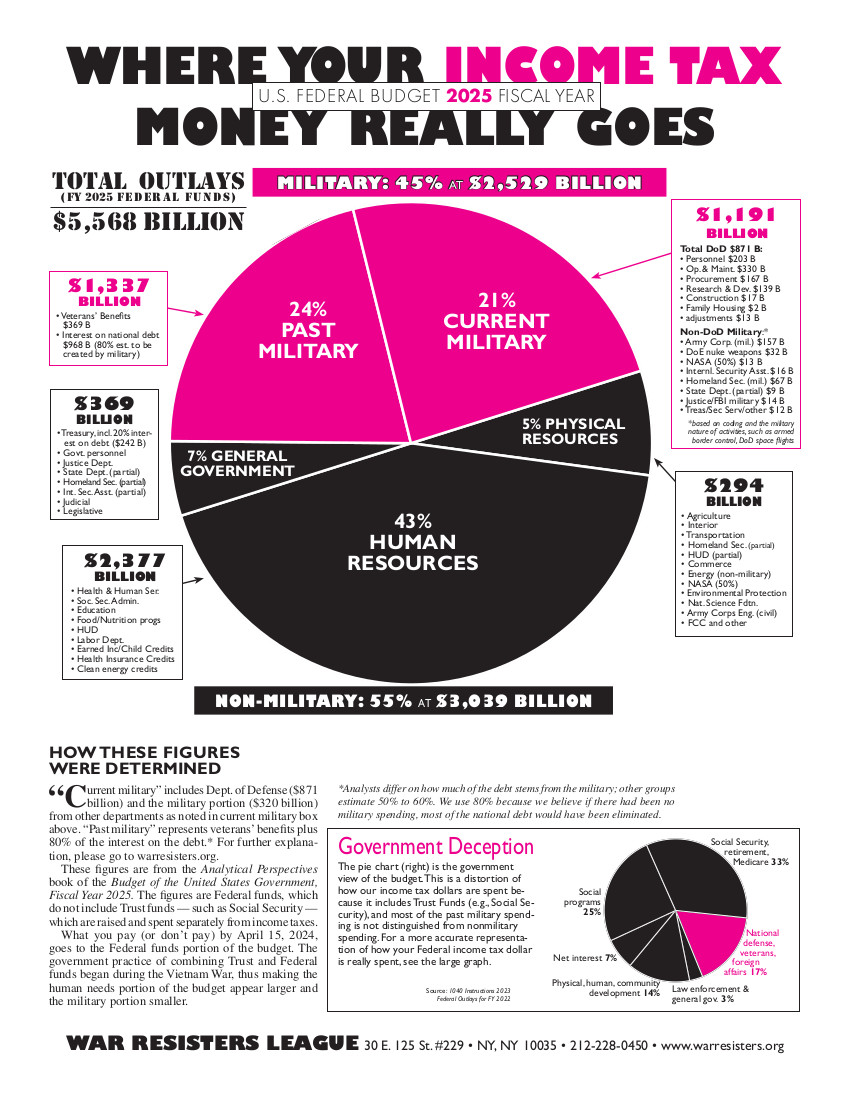
With the slogan “If the government won’t stop the war [in Vietnam], we’ll stop the government,” the largest mass arrests in U.S. history – 13,500 – occurred in May 1971 as hundreds of autonomous affinity groups from around the country converged on Washington, DC.
On May 1, a couple days before the action, more than 50,000 people gathered in West Potomac Park (renamed Algonquin Peace City by the organizers) for a rock concert headlined by The Beach Boys, many staying on in anticipation of the direct action. The next day the city revoked the permit and had several thousand police clear the park.
The May Day Tribe, composed of both non-pacifist and pacifist groups, including WRL, organized a week-long demonstration against the war. Three days of nonviolent direct action began very early on Monday, May 3rd, which was designed to bring the government to a halt with hundreds of demonstrators each blocking a couple dozen key intersections, bridges, and buildings throughout the city.
President Nixon called up the National Guard to assist the thousands of police, the 82nd Airborne paratroopers, the Armored Calvary Regiment, and the Marines. Tear gas and mace were used against many of the demonstrators.
 Photos: The Washington Post, May 4, 1971; Newsweek, May 17, 1971
Photos: The Washington Post, May 4, 1971; Newsweek, May 17, 1971

Among the 7,500 arrested that first day were the entire WIN magazine staff, most of the WRL nationall staff, many members of WRL's Executive and National Committees, and WRL local organizers from around the country.
On the next day, May 4th, as U.S. Attorney General John Mitchell and other officials looked on from their offices above, 4,000 were arrested blockading the Dept. of Justice building to protest the war as well as the indiscriminate nature of the arrests that swept the streets of demonstrators, reporters, and uninvolved citizens the previous day.
 Photo: Demonstrators at the U.S. Capitol shortly before 1,500 were arrested on May 5, 1971. Photo by Ed Hedemann
Photo: Demonstrators at the U.S. Capitol shortly before 1,500 were arrested on May 5, 1971. Photo by Ed Hedemann
Then on May 5th another 1,500 were arrested at a legal rally on the steps of the Capitol as they were being welcomed and addressed by Congresspeople Bella Abzug, Ron Dellums, Charlie Rangel, and Parren Mitchell. Antiwar organizer and activist Sid Peck spoke the final words as the police moved in, “We are here today to let the whole world know the Pentagon controls this government. We are here to let the people see that the poor are oppressed by this war. We are here to demonstrate to the world the repression of the military, that the people cannot even assemble in peace on the steps of the nation’s Capitol….” The rest of what he said was lost in the uproar of arrests.
 Photo: The MayDay Tactical Manual, produced by WRL and WIN magazine staffs
Photo: The MayDay Tactical Manual, produced by WRL and WIN magazine staffs
Jerry Coffin of the WRL national staff (on loan to the May Day Collective) and WIN magazine staff contributed to the organizing, particularly the research, writing, and production of the 24-page MayDay Tactical Manual. The manual explained nonviolent direct action, encouraged the use of affinity groups for decision-making, and identified 21 key protest sites throughout the city. It also became a model for future nonviolent direct action guides used during nuclear power plant and other occupations in the 1970s and early 1980s.
 Lacking sufficient police wagons, the government requisitioned U-Haul trucks among other nongovernment vehicles to transport arrestees. And because DC jails were overwhelmed, detention centers were set up at the RFK stadium practice field and the Washington Coliseum. As a show of solidarity, many in the Black community organized support for the imprisoned demonstrators by throwing sandwiches (some containing short messages of encouragement) and blankets over the fences of the detention center and into the Coliseum.
Lacking sufficient police wagons, the government requisitioned U-Haul trucks among other nongovernment vehicles to transport arrestees. And because DC jails were overwhelmed, detention centers were set up at the RFK stadium practice field and the Washington Coliseum. As a show of solidarity, many in the Black community organized support for the imprisoned demonstrators by throwing sandwiches (some containing short messages of encouragement) and blankets over the fences of the detention center and into the Coliseum.
Photo: Some of the thousands of protesters held at the Washington Coliseum, May 5, 1971. Photo by Lana Reeves.
In response to the illegality of the arrests, the ACLU filed a class action suit, which many years later forced Congress to agree to monetary settlements for the arrestees.
- Ed Hedemann, an organizer with Direct Action/Austin WRL local group, drove 24 hours nonstop from Austin, Texas, to Washington, DC, with several others in a VW microbus. He was among the 7,500 arrested on May 3, 1971, and was held at the Washington Coliseum. Two years later he joined the WRL national staff in NYC.
Sources:
WRL News, May-June 1971.
WRL Perpetual Calendar: 90 Years of Revolutionary Nonviolence, 2013.
WRL 100 Years of Resistance to War and the Causes of War, p. 38, 2023



